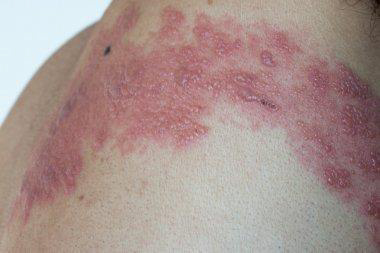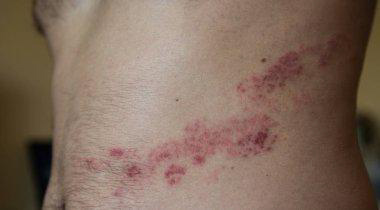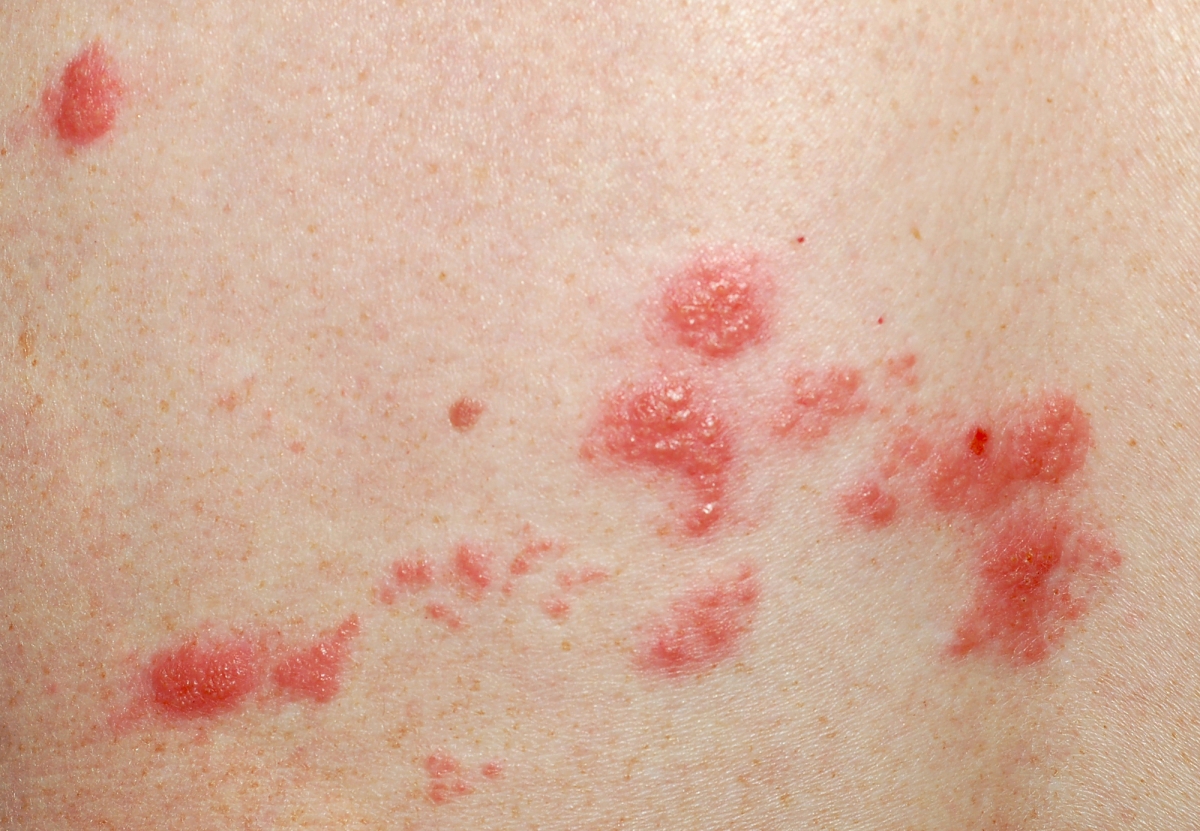Shingles is a viral infection that causes a painful rash. Shingles can occur anywhere on your body. It typically looks like a single stripe of blisters that wraps around the left side or the right side of your torso. Shingles is caused by the varicella-zoster virus — the same virus that causes chickenpox. After you’ve had chickenpox, the virus stays in your body for the rest of your life. Years later, the virus may reactivate as shingles.


VZV is also called herpesvirus 3 and is a member of the Herpesvirales order of double-stranded DNA viruses.
About 1 million cases of shingles are diagnosed every year in the U.S. The risk of shingles increases as you get older, with about half the cases occurring in people over the age of 50. Shingles develops in about 10% of people who have had chickenpox at an earlier time in their lives.
A person with shingles can pass the varicella-zoster virus to anyone who isn’t immune to chickenpox. This usually occurs through direct contact with the open sores of the shingles rash. Once infected, though, the person will develop chickenpox rather than shingles.
Herpes zoster often affects people with weak immunity. You can get shingles more than one time. One of the biggest myths about shingles is that it can only happen once. This isn’t true. You can have more than one episode. If you get shingles again, you usually don’t get the rash in the same place.
Cause:
After primary infection—varicella—VZV remains dormant in dorsal root ganglia nerve cells in the spine for years before it is reactivated and migrates down sensory nerves to the skin to cause herpes zoster.
It is not clear why herpes zoster affects a particular nerve fiber. Triggering factors are sometimes recognized, such as:
- Pressure on the nerve roots
- Radiotherapy at the level of the affected nerve root
- Spinal surgery
- An infection
- An injury (not necessarily to the spine)
- Contact with someone with varicella or herpes zoster
Clinical features:
Herpes zoster is characterized by dermatomal distribution, that is the blisters are confined to the cutaneous distribution of one or two adjacent sensory nerves. This is usually unilateral, with a sharp cut-off at the anterior and posterior midlines.
The clinical presentation of herpes zoster depends on the age and health of the patient and which dermatome is affected.
The first sign of herpes zoster is usually localized pain without tenderness or any visible skin change. It may be severe, relating to one or more sensory nerves. The pain may be just in one spot, or it may spread out. The patient may feel quite unwell with fever and headache. The lymph nodes draining the affected area are often enlarged and tender.
Within one to three days of the onset of pain, a blistering rash appears in the painful area of skin. It starts as a crop of red papules. New lesions continue to erupt for several days within the distribution of the affected nerve, each blistering or becoming pustular and then crusting over.
The chest (thoracic), neck (cervical), forehead (ophthalmic) and lumbar/sacral sensory nerve supply regions are most commonly affected at all ages. The frequency of ophthalmic herpes zoster increases with age. Herpes zoster occasionally causes blisters inside the mouth or ears, and can also affect the genital area. Sometimes there is pain without rash.
Pain and general symptoms subside gradually as the eruption disappears. In uncomplicated cases, recovery is complete within 2–3 weeks in children and young adults, and within 3–4 weeks in older patients.
It can take three to five weeks from the time you begin to feel symptoms until the rash totally disappears.
First, a few days before the rash appears, you may feel pain in an area on your skin. The pain is described as itching, burning, stabbing or shooting. This usually happens before the rash comes.
Next, the raised rash appears as a band or a patch, usually on one side of your body. The rash usually appears around your waistline or on one side of your face, neck, or on the trunk (chest/abdomen/back), but not always. It can occur in other areas including your arms and legs.
Within three to four days, the rash develops into red, fluid-filled, painful, open blisters.
Usually, these blisters begin to dry out and crust over within about 10 days.
The scabs clear up about two to three weeks later.
Complications of herpes zoster:
- Involvement of several dermatomes, or sometimes, bilateral eruptions in unique dermatomes
- Eye complications when the ophthalmic division of the fifth cranial nerve is involved
- Deep blisters that take weeks to heal followed by scarring
- Muscle weakness in about one in 20 patients. Facial nerve palsy is the most common result. There is a 50% chance of complete recovery, but some improvement can be expected in nearly all cases
- Infection of internal organs, including the gastrointestinal tract, lungs, and brain (encephalitis)
- Herpes zoster is infectious to people who have not previously had chickenpox.
- Herpes zoster in the early months of pregnancy can harm the fetus, but luckily this is rare. Shingles in late pregnancy can cause chickenpox in the fetus or newborn. Herpes zoster may then develop as an infant.
Post-herpetic neuralgia
Post-herpetic neuralgia is defined as persistence or recurrence of pain in the same area, more than a month after the onset of herpes zoster. It becomes increasingly common with age, affecting about a third of patients over 40. It is particularly likely if there is facial infection. Post-herpetic neuralgia may be a continuous burning sensation with increased sensitivity in the affected areas or spasmodic shooting pain. The overlying skin is often numb or exquisitely sensitive to touch. Sometimes, instead of pain, the neuralgia results in a persistent itch (neuropathic pruritus).
Risk factors include:
Anyone who has ever had chickenpox can develop shingles. Most adults in the United States had chickenpox when they were children. That was before the availability of the routine childhood vaccination that now protects against chickenpox.
- Age: The risk of developing shingles increases with age. Shingles typically occur in people older than 50. And people over the age of 60 are more likely to experience more severe complications.
- Some diseases: Diseases that weaken your immune system, such as HIV/AIDS and cancer, can increase your risk of shingles.
- Cancer treatments: Radiation or chemotherapy can lower your resistance to diseases and may trigger shingles.
- Some medications: Drugs that prevent rejection of transplanted organs can increase your risk of shingles. Long-term use of steroids, such as prednisone, may also increase your risk of developing shingles.
Complications from shingles can include:
- Postherpetic neuralgia: For some people, shingles pain continues long after the blisters have cleared. This condition is known as postherpetic neuralgia. It occurs when damaged nerve fibers send confused and exaggerated messages of pain from your skin to your brain.
- Vision loss: Shingles in or around an eye (ophthalmic shingles) can cause painful eye infections that may result in vision loss.
- Neurological problems: Shingles may cause inflammation of the brain (encephalitis), facial paralysis, or problems with hearing or balance.Skin infections: If shingles blisters aren’t properly treated, bacterial skin infections may develop.
Prevention:
A shingles vaccine may help prevent shingles. People who are eligible should get the Shingrix vaccine, which has been available in the United States since its approval by the Food and Drug Administration in 2017. The Zostavax vaccine is no longer available in the U.S, but other countries may still use it.
Shingrix is approved and recommended for people age 50 and older, whether they’ve had shingles or not. People who’ve had the Zostavax vaccine in the past or don’t know whether they’ve had chickenpox may also receive the Shingrix vaccine.
Shingrix is also recommended for people who are 19 years of age and older who have weakened immune systems due to disease or medication.
Shingrix is a nonliving vaccine made of a virus component. It’s given in two doses, with 2 to 6 months between doses. The most common side effects of the shingles vaccine are redness, pain and swelling at the injection site. Some people also experience fatigue, headache and other side effects. The shingles vaccine doesn’t guarantee that you won’t get shingles. But this vaccine will likely reduce the course and severity of the disease. And it will likely lower your risk of postherpetic neuralgia. Studies suggest that Shingrix offers protection against shingles for more than five years.
Talk to your health care provider about your vaccination options if you:
- Have had an allergic reaction to any component of the shingles vaccine
- Have a weakened immune system due to a condition or medication
- Have had a stem cell transplant
- Are pregnant or trying to become pregnant
- The shingles vaccine is used only as a way to prevent shingles. It’s not intended to treat people who currently have the disease.
There is no cure for shingles but there are treatments for managing the symptoms.
- General measures
- Rest and pain relief
- Protective ointment applied to the rash, such as petroleum jelly.
- Oral antibiotics for secondary infection
Antiviral medications
These drugs may ease the discomfort and make the symptoms stop sooner, particularly if you start them within 72 hours of the first sign of shingles. They may also help prevent the pain that can happen months and years later, called postherpetic neuralgia. These medications include:
- Acyclovir
- Famciclovir
- Valacyclovir
Over-the-counter pain medications may be effective in relieving pain:
- Acetaminophen, Ibuprofen
- Other medications
Antibacterial drugs may be prescribed if you develop a bacterial infection due to the shingles rash. Anti-inflammatory drugs like prednisone may be prescribed if shingles affect your eyes or other parts of your face.


